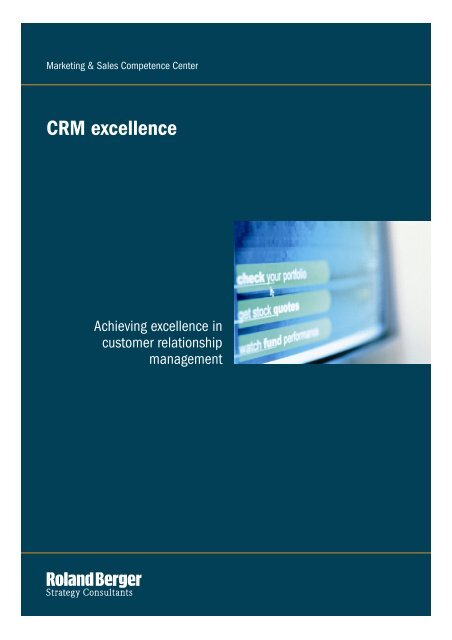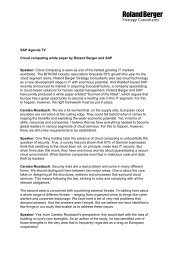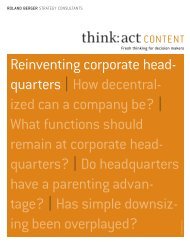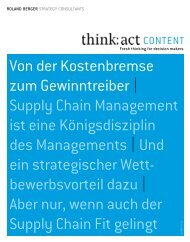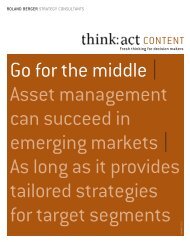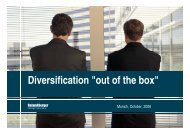CRM excellence - Roland Berger
CRM excellence - Roland Berger
CRM excellence - Roland Berger
You also want an ePaper? Increase the reach of your titles
YUMPU automatically turns print PDFs into web optimized ePapers that Google loves.
Marketing & Sales Competence Center<br />
<strong>CRM</strong> <strong>excellence</strong><br />
Achieving <strong>excellence</strong> in<br />
customer relationship<br />
management
<strong>CRM</strong> <strong>excellence</strong><br />
Page 2<br />
<strong>CRM</strong> <strong>excellence</strong><br />
<strong>Roland</strong> <strong>Berger</strong> supports you in achieving <strong>CRM</strong> <strong>excellence</strong> with tailored approaches depending on your<br />
business and route-to-market strategy:<br />
Customer segmentation: Understanding customer value, loyalty and needs<br />
Direct marketing/<strong>CRM</strong>: Setting up targeted one-to-one dialog strategies<br />
Channel-based <strong>CRM</strong>: Managing customers through channel partners<br />
Loyalty programs: Developing effective customer loyalty programs<br />
The <strong>CRM</strong> hype is over, the strategic necessity<br />
remains<br />
Customer relationships may well be the most important<br />
asset of virtually every sales and marketing-driven business.<br />
However, building customer loyalty with targeted offerings<br />
is a tough job, as mounting global competition makes<br />
products and services increasingly similar. At the same<br />
time, however, customer needs and tastes are becoming<br />
more and more varied.<br />
Customer relationship management, or <strong>CRM</strong>, emerged as<br />
a hot topic at the end of the 1990s. Since then, many<br />
companies have invested millions into <strong>CRM</strong> processes and<br />
IT platforms. While <strong>CRM</strong> has become a standard tool in<br />
industries such as financial services, airlines, hotels and<br />
rental cars, many companies have not yet realized appropriate<br />
returns on their <strong>CRM</strong> investments.<br />
Lack of focus and insufficient integration into existing<br />
processes and strategies have proven to be particularly<br />
severe pitfalls.<br />
While the <strong>CRM</strong> hype has come to an end, the strategic<br />
necessity to gain insight into customer behavior and access<br />
to individual customers – to boost market share and improve<br />
marketing efficiency – has certainly not faded.<br />
Our comprehensive <strong>CRM</strong> <strong>excellence</strong> approach helps our<br />
clients better understand their customers. Using value and<br />
needs-based customer segmentation, we work out the right<br />
strategy to access, gain and retain customers in the most<br />
efficient and effective way possible. The pillars of <strong>CRM</strong><br />
<strong>excellence</strong> are tailor-made approaches for first segmenting<br />
and then managing customers either directly, through<br />
channel partners or with loyalty programs.<br />
<strong>CRM</strong> <strong>excellence</strong> –<br />
overview<br />
Core <strong>CRM</strong><br />
processes<br />
INSIGHT<br />
Understand<br />
customers &<br />
markets<br />
ACCESS<br />
Build <strong>CRM</strong><br />
capabilities &<br />
infrastructure<br />
GAIN & RETAIN<br />
Develop targeted<br />
propositions on<br />
micro/1:1 level<br />
EFFICIENCY &<br />
EFFECTIVENESS<br />
Calibrate measures<br />
based on ROI<br />
<strong>Roland</strong> <strong>Berger</strong><br />
tools &<br />
products<br />
I<br />
Customer<br />
segmentation<br />
II Direct marketing/<strong>CRM</strong> (direct route to market)<br />
III Channel-based <strong>CRM</strong> (indirect route to market)<br />
IV Loyalty programs/HELP (3rd party & program based)
<strong>CRM</strong> <strong>excellence</strong><br />
Page 3<br />
Customer segmentation: Understanding<br />
customer value, loyalty and needs<br />
A thorough understanding of customers and markets is the<br />
key prerequisite for all <strong>CRM</strong> activities. If you analyze your<br />
qualitative and quantitative data comprehensively, you are<br />
very likely to develop successful <strong>CRM</strong> activities. The<br />
analyses focus on three key objectives:<br />
> Identify high value/high potential customers in order<br />
to channel limited resources<br />
> Assess current customer loyalty to identify customers<br />
at risk<br />
> Understand customer purchasing behavior to offer<br />
targeted propositions<br />
All these analyses result in a customer segmentation that<br />
indicates target customer groups as well as their needs<br />
and purchasing patterns. This is the foundation of all <strong>CRM</strong><br />
activities, whether direct or indirect. To recommend and<br />
implement the appropriate <strong>CRM</strong> approach, we use a set<br />
of pragmatic tools. They have proven successful in many<br />
projects and are customized to suit each of our client's<br />
specific needs.<br />
<strong>CRM</strong> analytics (project example)<br />
1<br />
2<br />
3<br />
Identify high value<br />
customers<br />
Assess static and dynamic<br />
customer loyalty<br />
Cluster customers based<br />
on needs and purchasing<br />
patterns<br />
Selecting the right <strong>CRM</strong> approach for<br />
our client<br />
Direct marketing/<strong>CRM</strong>: Setting up targeted one-ononedialog<br />
strategies<br />
Once our client's target customers have been identified,<br />
direct marketing is the traditional, straightforward way to<br />
approach them. Whenever a company has direct access to<br />
its customers, direct marketing is the most effective form of<br />
<strong>CRM</strong> activities. Unlike classic marketing, direct marketing<br />
allows companies to address each customer individually.<br />
It creates the highest level of intimacy with customers and<br />
best fulfills customer needs.<br />
It is vital for a company to make sure that its direct marketing<br />
strategy is comprehensive and long term. Direct <strong>CRM</strong><br />
activities strongly define a company's perceived image,<br />
value proposition, emotional connotations and credibility.<br />
We offer support in setting up a successful 1:1 dialog with<br />
customers. Based on thorough customer understanding, we<br />
assist our clients in designing their direct marketing strategy<br />
and creating successful <strong>CRM</strong> activities that can easily be<br />
implemen-ted. In order to ensure that these <strong>CRM</strong> activities<br />
are effective, we measure the success of all activities with a<br />
customized ROMI approach.<br />
Channel-based <strong>CRM</strong>: Managing customers by channel<br />
partners<br />
Traditionally, <strong>CRM</strong> activities have focused on establishing<br />
direct contact to end customers. In order to do so,<br />
companies either had to sell directly or they had to bypass<br />
the channels with their <strong>CRM</strong> activities. For companies<br />
operating in an indirect sales environment, our innovative<br />
channel-based <strong>CRM</strong> approach now offers a state-of-the-art<br />
alternative to the time and cost-intensive direct customer<br />
contact.
2002 2003 2004 2005 2006 2007<br />
2002 2003 2004 2005 2006<br />
Worst Case Base Case Best Case<br />
<strong>CRM</strong> <strong>excellence</strong><br />
Page 4<br />
Our approach focuses on a neutral third party platform that<br />
serves as an intermediary between our clients and their<br />
channel partners. These kinds of <strong>CRM</strong> infrastructures enable<br />
our clients to analyze the database of participating resellers<br />
without the channel partner having to disclose confidential<br />
customer details. Our clients may now identify high value<br />
customers, assess their loyalty and offer targeted<br />
propositions on a 1:1 or micro-segment level through the<br />
channel partners. We have applied this approach with<br />
leading multinational corporations.<br />
"HELP": Developing effective customer loyalty programs<br />
Parameters are individually determined, benchmarked and<br />
checked against heuristic values from more than 100 loyalty<br />
programs in the HELP research database.<br />
With respect to our clients' objectives, HELP can avoid<br />
pitfalls and help prepare a value-driven, rational and robust<br />
decision on whether and how a loyalty program can meet<br />
these objectives. Once a loyalty program has been<br />
identified, HELP designs the detailed architecture of the<br />
individual best practice solution. The implementation is<br />
embedded in and adapted to our clients' overall <strong>CRM</strong><br />
activities.<br />
"HELP" stands for "Holistic Evaluation of Loyalty<br />
Programs". HELP is a set of tools that create a unique<br />
quantitative understanding of the economic impact of a<br />
loyalty program. The tools assist our clients in efficiently<br />
allocating the significant investments necessary to create,<br />
increase and maintain customer loyalty. The economic<br />
impact is calculated in a complex scenario model<br />
comprising 137 parameters which include all major drivers:<br />
the specific situation of the company and the market, the<br />
architecture of the program and customer and competitor<br />
behavior.<br />
Assessing the impact of loyalty programs<br />
INPUT<br />
ROLAND BERGER HELP TOOL<br />
> Company-specific<br />
data<br />
> Market data<br />
> Scenario values<br />
(worst, base and<br />
best case)<br />
1<br />
2<br />
Evaluate payback<br />
period<br />
Develop sales &<br />
market share<br />
3<br />
Impact on capital/<br />
company value (NPV)


